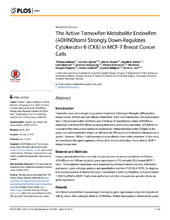The Active Tamoxifen Metabolite Endoxifen (4OHNDtam) Strongly Down-Regulates Cytokeratin 6 (CK6) in MCF-7 Breast Cancer Cells
Helland, Thomas; Gjerde, Jennifer; Dankel, Simon N; Fenne, Ingvild Sveinsgjerd; Skartveit, Linn; Drangevåg, Andreas; Bozickovic, Olivera; Flågeng, Marianne Hauglid; Søiland, Håvard; Mellgren, Gunnar; Lien, Ernst Asbjørn
Peer reviewed, Journal article
Published version

View/
Date
2015-04-13Metadata
Show full item recordCollections
Original version
https://doi.org/10.1371/journal.pone.0122339Abstract
Introduction: Tamoxifen is an anti-estrogen drug used in treatment of Estrogen Receptor (ER) positive breast cancer. Effects and side effects of tamoxifen is the sumof tamoxifen and all itsmetabolites. 4-Hydroxytamoxifen (4OHtam) and 4-hydroxy-N-demethyltamoxifen (4OHNDtam, endoxifen) both have ER affinity exceeding that of the parent drug tamoxifen. 4OHNDtam is considered the main active metabolite of tamoxifen. Ndesmethyltamoxifen (NDtam) is the major tamoxifen metabolite. It has low affinity to the ER and is not believed to influence tumor growth. However, NDtam might mediate adverse effects of tamoxifen treatment. In this study we investigated the gene regulatory effects of the three metabolites of tamoxifen in MCF-7 breast cancer cells. Material and Methods: Using concentrations that mimic the clinical situation we examined effects of 4OHtam, 4OHNDtam and NDtam on global gene expression in 17β-estradiol (E2) treated MCF-7 cells. Transcriptomic responses were assessed by correspondence analysis, differential expression, gene ontology analysis and quantitative real time PCR (Q-rt-PCR). E2 deprivation and knockdown of Steroid Receptor Coactivator-3 (SRC-3)/Amplified in Breast Cancer 1 (AIB1) mRNA in MCF-7 cells were performed to further characterize specific effects on gene expression. Results: 4OHNDtam and 4OHtamcausedmajor changes in gene expression compared to treatment with E2 alone, with a stronger effect of 4OHNDtam. NDtam had nearly no effect on the global gene expression profile. Treatment ofMCF-7 cells with 4OHNDtam led to a strong down-regulation of the CytoKeratin 6 isoforms (KRT6A, KRT6B and KRT6C). The CytoKeratin 6 mRNAs were also down-regulated inMCF-7 cells after E2 deprivation and after SRC-3/ AIB1 knockdown. Conclusion: Using concentrations that mimic the clinical situation we report global gene expression changes that were most pronounced with 4OHNDtam and minimal with NDtam. Genes encoding CytoKeratin 6, were highly down-regulated by 4OHNDtam, as well as after E2 deprivation and knockdown of SRC-3/AIB1, indicating an estrogen receptor-dependent regulation.
